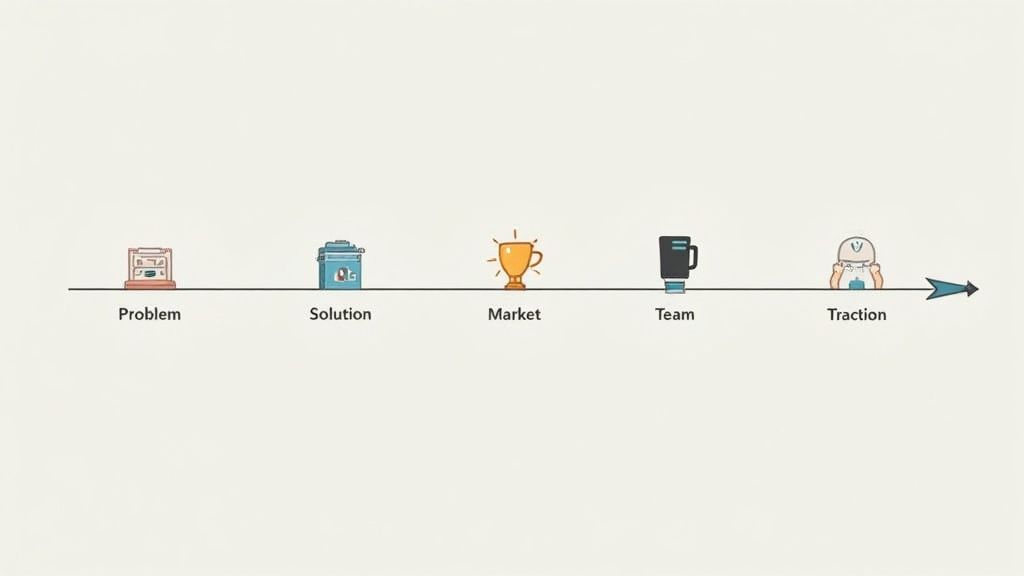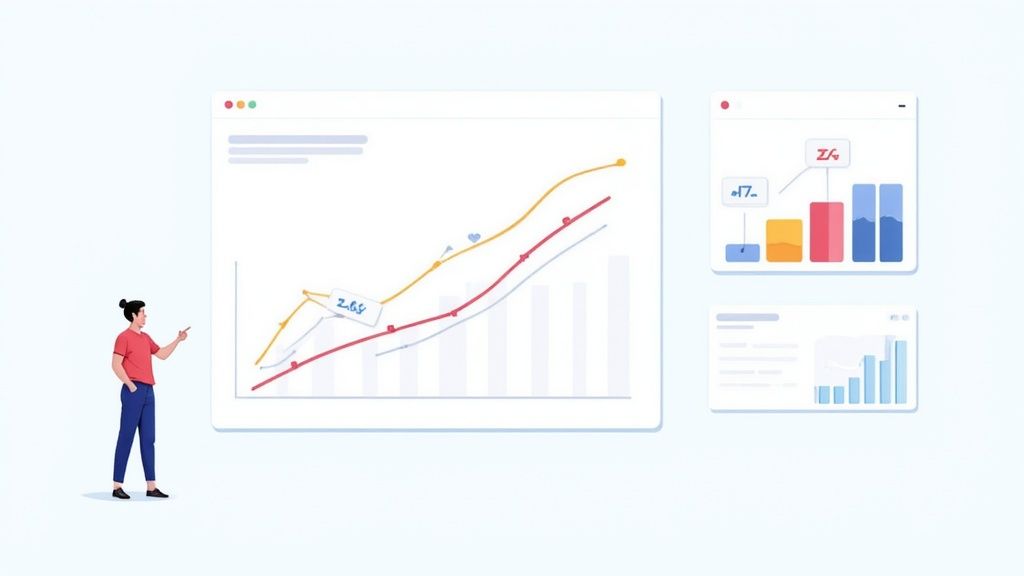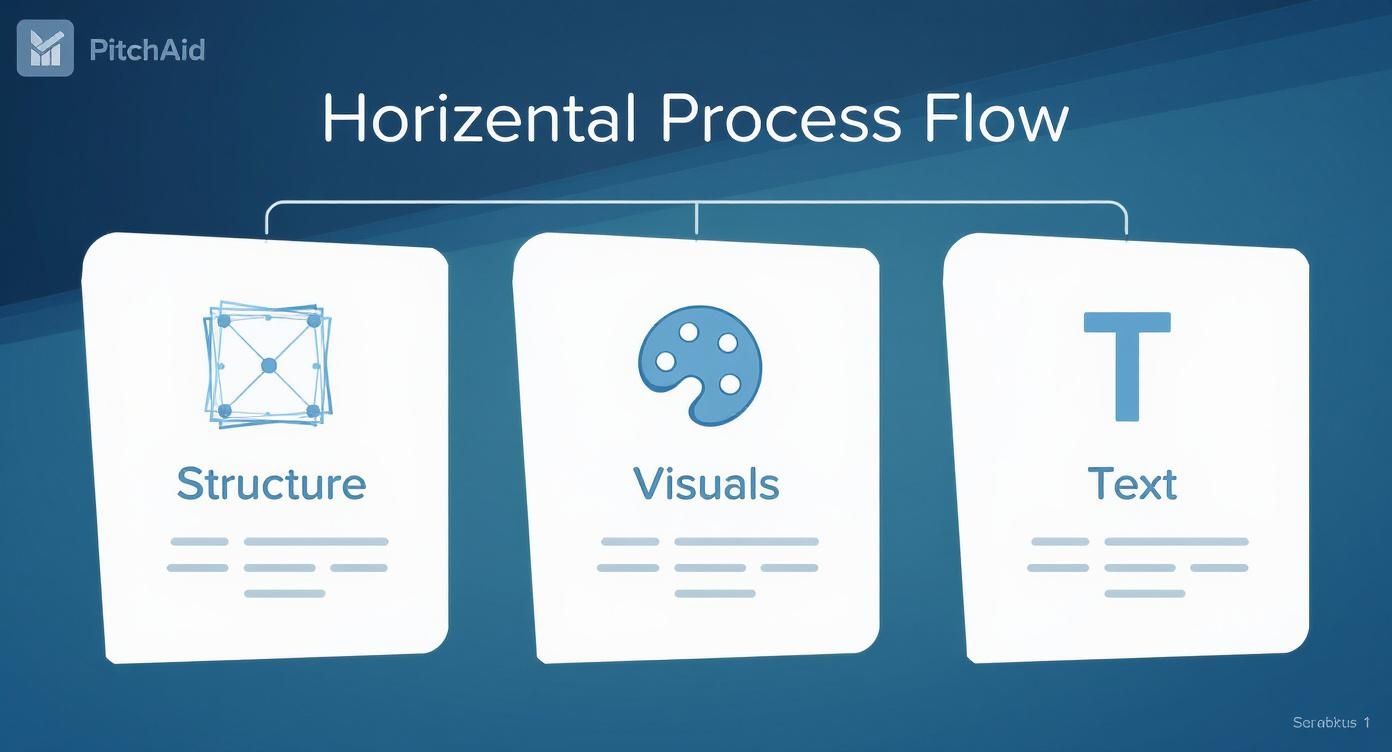Let's be real. Creating a pitch deck that gets funded comes down to three things: a killer story, rock-solid data, and a vision that’s impossible for investors to ignore. It’s not about cramming every detail of your business into 20 slides. It’s about making an investor get it—your idea, your team, and your massive opportunity—in under four minutes. Nail that, and you're already ahead of the game.
What Investors Really Want to See in the First Three Minutes

You have less time than you think. An often-cited Harvard Business School study found VCs spend just 3 minutes and 44 seconds on the average pitch deck. More recent data is even tougher—in 2023, the average viewing time for seed-stage decks dipped below two minutes for the first time.
This means your first few slides have to do some serious heavy lifting. Investors aren't looking for buzzwords or flashy designs right away. They're scanning for core signals that prove your business is a real contender. Your job is to get the critical information on the table immediately, turning your presentation into a story about a painful problem, your brilliant solution, and a huge market waiting to be captured.
The Make-or-Break First Impression
Think of this initial scan as an investor’s pre-flight checklist. They’re running through a few fundamental questions to decide if your deck is worth a deeper look. Your job is to make the answers jump right off the page.
They need to see three things almost instantly:
- What you do: What problem are you solving, and who is it for?
- Why it matters: Is this market big enough to generate a huge return?
- Why you’ll win: Do you have the traction and team to make it happen?
If an investor can't piece this together in 60 seconds, you’ve probably lost them. And the data shows where their priorities lie: investors are spending 48% more time on business model slides and 25% more on traction slides than they used to.
To give yourself a massive head start, it pays to understand what investors are looking for. Resources like the 21 Business Model Checks Investors Expect You To Pass show you exactly which parts of your model will get the most scrutiny.
The 3-Minute Investor Checklist
Before you get lost in the details, make sure your deck passes this rapid-fire test. This table breaks down what an investor is trying to figure out in those first few moments.
| Investor Question | Where to Answer It | Why It Matters |
|---|---|---|
| What do you do? | Problem, Solution, Value Prop | Instantly filters out ideas they don't understand or care about. |
| Is the market big? | Market Size | They need to see the potential for a 10x or 100x return. |
| Do you have proof? | Traction | Shows you're not just an idea; you have real-world validation. |
| Why is your team the one? | Team | They bet on founders as much as ideas. Establishes credibility. |
Nailing these four points upfront is how you earn their full attention for the rest of your deck.
Building Your Hook
So, how do you grab them from slide one? Start with absolute clarity. Cut the jargon. Instead of saying you’re a "synergistic platform for B2B optimization," say "We help companies cut their software spending by 30%." See the difference? One is corporate-speak; the other is a clear, compelling outcome.
Your opening needs to be simple and powerful.
The key is to create a logical and emotional connection right away. Show them a world with a problem, then introduce your company as the inevitable solution. Make them feel like your success is a foregone conclusion.
This isn't just about listing facts. It's about building a case so compelling that an investor leans in and thinks, "Okay, tell me more." The rest of your deck provides the proof, but those first three minutes decide if they’ll ever get there.
Crafting Your Story with Essential Pitch Deck Slides
 A great pitch deck isn't just a collection of facts and figures. It’s a story. It’s a narrative that grabs an investor by the hand and guides them from a painful problem to your brilliant, inevitable solution. Each slide is a chapter, building on the last and setting the stage for what’s next.
A great pitch deck isn't just a collection of facts and figures. It’s a story. It’s a narrative that grabs an investor by the hand and guides them from a painful problem to your brilliant, inevitable solution. Each slide is a chapter, building on the last and setting the stage for what’s next.
Think of it as a classic three-act play. First, you set the scene (the problem). Then, you bring in the hero (your product). Finally, you reveal the triumphant ending—a massive market and a clear path to victory.
This is your slide-by-slide blueprint. We're skipping the generic templates to focus on the why behind each slide, helping you turn your raw ideas into a seamless, persuasive journey.
Setting the Stage: The Problem and Solution
Your story has to start by grounding the investor in a world they understand—one with a real, significant problem. Don't just state the issue; make them feel the pain.
Your Problem Slide is all about the "why" behind your entire company. Frame it in a relatable, urgent way. Instead of "inefficient enterprise workflows," try "teams are burning 10 hours a week on manual data entry." One is jargon; the other is money down the drain.
Then comes the hero's entrance: the Solution Slide. This slide must directly mirror the problems you just laid out, presenting your product as the clean, elegant answer. Keep it high-level. This isn’t a feature list; it’s about the core value you deliver. If the problem is wasted time, your solution is giving that time back. Simple.
Showcasing Your Genius: The Product and Business Model
Now that you’ve hooked them, it's time to show how your product actually works and, crucially, how you’ll make money. This is where your story gets real.
Your Product Slide, or "How It Works," needs to demystify your offering. A simple 3-step diagram, a few clean screenshots, or a short GIF can walk an investor through the user journey. The goal is that "aha!" moment where they instantly get what you do.
Next up, the Business Model Slide explains how your solution becomes a profitable business. Don’t overcomplicate this. State your model clearly—"SaaS with three pricing tiers"—and show your core pricing. This slide proves you’ve thought about monetization from day one.
Investor Takeaway: A simple business model is a confident one. If an investor can't figure out how you make money in 10 seconds, you’ve already made it too complex. Clarity builds trust.
Proving the Potential: The Market and Competition
Every great story needs high stakes. For investors, that means a massive market opportunity. This is where you zoom out from your product and show them the sheer scale of the prize.
Your Market Size Slide needs to be both ambitious and believable. Use the classic TAM, SAM, SOM model to break it down:
- Total Addressable Market (TAM): The entire global market for your solution.
- Serviceable Available Market (SAM): The segment of that market you can realistically reach.
- Serviceable Obtainable Market (SOM): Your specific, achievable target for the next 3-5 years.
This framework shows investors you have a huge vision but also a practical, focused plan to get started. Sourcing your data from credible reports adds immense weight to your claims.
Of course, a big market attracts others. Your Competition Slide is where you prove you understand the landscape and have a unique edge. A simple 2x2 matrix plotting your company against competitors on key value axes (like "Price" vs. "Ease of Use") is a powerful way to visualize your unique position. Frame your competition as validation that the market exists, then show precisely why you’re built to win it.
Why You Will Win: The Team and Traction
This is the climax of your story. You've laid out a problem, a solution, and a huge market. Now, you have to convince them that your team is the only one that can make it all happen.
The Team Slide is often the most scrutinized slide in the entire deck. Investors bet on people first, ideas second. This is where you highlight truly relevant experience—previous exits, key roles at major tech companies, or deep domain expertise. Show a balanced team that covers tech, product, and sales.
Finally, your Traction Slide delivers the proof. This is where you quiet any lingering doubts with hard numbers. Early-stage startups can show impressive waitlist sign-ups or positive pilot program results. More mature companies should feature core metrics like:
- Monthly Recurring Revenue (MRR)
- User Growth Rate
- Customer Acquisition Cost (CAC)
- Lifetime Value (LTV)
Strong traction proves your model isn’t just a theory; it’s already working. To see how leading companies have structured these crucial slides, it's worth exploring some of the best pitch deck examples from startups that went on to secure major funding.
The Final Ask
Every good story needs a clear conclusion. Your Ask Slide brings it all home. State exactly how much funding you’re raising and provide a simple breakdown of how you’ll use that capital (e.g., 40% for product, 30% for marketing, 30% for new hires). This connects their investment directly to your future milestones, making it a clear and compelling call to action.
Using Data to Prove Your Business Model and Traction

Ideas are a dime a dozen. What gets a check written is proof that your idea works in the real world. This is the part of your pitch where you swap storytelling for cold, hard facts—proving you can turn your vision into a scalable, profitable business.
Your traction slide isn't just a graph going up and to the right; it's the heartbeat of your company. It shows you understand your business model inside and out, and more importantly, that customers are responding. This is your chance to build undeniable credibility.
Choosing the Metrics That Matter
Not all data is created equal. The key performance indicators (KPIs) you highlight have to directly reflect the health of your specific business model. An investor looking at a SaaS company cares about completely different numbers than one evaluating a D2C brand.
Your job is to pick the 3-4 most powerful KPIs that prove your core assumptions are correct.
Here’s a quick breakdown of which metrics matter for common business models:
- SaaS (Software as a Service): Focus on Monthly Recurring Revenue (MRR), Churn Rate, and Customer Lifetime Value (LTV) to show predictable income and customer stickiness.
- Marketplace: Showcase your Gross Merchandise Volume (GMV), your take rate (commission), and user growth on both the supply and demand sides.
- D2C (Direct-to-Consumer): Highlight your Customer Acquisition Cost (CAC), Average Order Value (AOV), and repeat purchase rate to prove you can acquire customers profitably.
The goal is a clear financial narrative that an investor can follow in seconds. It shows you're focused on the numbers that drive sustainable growth.
The Holy Grail of SaaS Metrics: CAC and LTV
For many startups, the relationship between two metrics tells almost the entire story: Customer Acquisition Cost (CAC) and Lifetime Value (LTV).
CAC is what it costs you to get a new customer. LTV is the total revenue you expect from them over time. The ratio between these two is a brutally honest indicator of your business model's efficiency.
Investors obsess over these numbers. The widely accepted benchmark is an LTV:CAC ratio of at least 3:1. This shows that for every dollar you spend getting a customer, you make at least three dollars back. It's mathematical proof that your growth engine works.
Investor Insight: A strong LTV to CAC ratio is one of the clearest signals that you've found product-market fit. It's proof your business engine actually works.
Showcasing Early Traction (Even Pre-Revenue)
"But what if I don't have revenue yet?" This is a classic founder question. The good news is "traction" doesn't always mean "sales." You can demonstrate powerful momentum long before your first dollar comes in.
If you're pre-revenue, focus on metrics that prove demand and de-risk the investment. Think about the early signals that validate your idea.
Here are some powerful pre-revenue traction points to show off:
- Waitlist Sign-ups: A long, growing list of people eager for your product is a powerful indicator of demand.
- Pilot Program Results: Show data from successful pilots, including user engagement metrics and glowing testimonials.
- Letters of Intent (LOIs): Signed LOIs are gold. They show potential customers are serious enough to put their name on paper.
- User Engagement: If you have a free version, highlight metrics like Daily Active Users (DAU) or session duration to prove people love using what you've built.
Knowing how to measure user satisfaction effectively can also give you a huge edge. A high Net Promoter Score (NPS) can be just as compelling as early revenue.
Turning Numbers into a Narrative
Finally, remember that how you present your data is just as important as the data itself. A cluttered slide packed with tiny numbers is an instant turn-off. Your data slides need to be clean, visual, and dead simple to understand.
Use simple charts to show growth over time. Label your axes clearly and use big, bold call-outs to highlight your most impressive numbers, like “80% MoM User Growth” or “LTV:CAC ratio of 4:1.”
Your pitch deck is a story, and the data section is the climax—the part where you prove the story is real. By picking the right KPIs and presenting them clearly, you build the credibility you need to get investors excited about writing that check.
Designing a Pitch Deck That Sells Your Vision
Let’s be honest: your pitch deck’s design is more than just pretty packaging. It’s the first evidence an investor sees of your attention to detail. A clean, professional deck signals a founder who’s in control. A sloppy one hints at a sloppy business.
You don’t need to be a graphic designer to pull this off. The goal is clarity, not artistic genius. It’s about using simple design to make your key messages hit home with real impact.
Think of design as the silent partner in your pitch. It works in the background to make your story easier to digest and your data impossible to ignore.
Establish a Clean and Consistent Visual Identity
Before you drop any text onto a slide, you need a visual foundation. Consistency is everything. A deck that flips between different fonts, colors, and logos on every slide feels chaotic and amateurish.
Your visual identity only needs a few core elements:
- A Simple Color Palette: Stick to 2-3 primary colors. Use your main brand color for headlines, a neutral tone for backgrounds, and an accent color for charts.
- Legible Fonts: Choose one font for headings and another for body text. Easy readability is non-negotiable. A classic combo, like a bold sans-serif for titles (think Helvetica) and a clean sans-serif for paragraphs (like Lato), works beautifully.
- Your Logo: Place your logo in the same spot on every slide, usually a corner. This small move makes your entire presentation feel cohesive and professional.
This isn’t about winning design awards. It’s about eliminating distractions so your big ideas can take center stage.
Pro Tip: When in doubt, keep it simple. The most effective pitch decks use a ton of white space. It gives your content room to breathe and makes each slide feel sharp and intentional.
Use Visuals to Tell Your Story
Words alone will only get you so far. The human brain processes images 60,000 times faster than text, which makes visuals your secret weapon. When you're figuring out how to create a pitch deck that connects, powerful visuals are essential.
Your product mockups and charts aren’t just filler—they’re proof.
- Product Mockups: Don't just tell investors about your app; show them. Clean screenshots framed inside a phone or laptop make your product feel real.
- Data Visualization: A clean bar chart showing your monthly revenue growth is infinitely more persuasive than a paragraph trying to describe it.
- Icons and Diagrams: Use simple icons to represent concepts and break up text. A quick three-step diagram can explain your business model way more effectively than a dense bulleted list.
Every visual should serve a purpose. If it doesn't clarify your point or make your data more impactful, it's just noise. Our guide on what makes a good presentation has some great insights on crafting compelling visuals.
Design Dos and Don'ts for Your Pitch Deck
Trying to navigate design choices can feel overwhelming, but a few basic rules will keep you on track. Here’s a quick guide to help you sidestep common mistakes.
| Do This | Don't Do This | The Reason Why |
|---|---|---|
| Use High-Quality Images | Use pixelated or generic stock photos | Poor quality visuals make your brand look cheap and unprofessional. |
| Stick to One Idea Per Slide | Cram multiple points onto a single slide | Simplicity ensures your main message lands without overwhelming the viewer. |
| Maintain Visual Hierarchy | Make all text the same size | Different font sizes guide the reader’s eye to what matters most. |
| Ensure High Contrast | Use light text on a light background | Your text has to be easy to read. Low contrast strains the eyes and makes your content inaccessible. |
At the end of the day, great design should feel invisible. It works so seamlessly that the investor isn’t thinking about your font choice—they’re completely focused on your vision.
How to Build Your Pitch Deck in Minutes Instead of Weeks
The old way of building a pitch deck was a total grind. We’ve all been there: staring at a blank slide, wrestling with layouts, and trying to cram a storm of ideas into a story that makes sense. It was slow and frustrating.
But what if you could create a polished first draft in the time it takes to grab a coffee? This isn’t about cutting corners—it’s about working smarter. The modern approach gets you from a messy brain dump to a structured, compelling deck in minutes.
From Messy Notes to a Polished Draft
The biggest hurdle is almost always getting started. That initial writer's block can feel like hitting a wall. This is where tools designed to speed up your workflow are a game-changer.
Imagine turning a simple prompt or a page of rough notes into a fully outlined presentation. With a tool like GenPPT, that’s exactly what you can do. Instead of spending hours building a structure from scratch, you get a logical flow with all the essential slides—problem, solution, market size, team—ready for you to refine. It’s like having an expert co-founder for building narratives.
This flips the script entirely. You stop being a slide builder and become a storyteller, free to focus on what actually matters: honing your message.
Let AI Handle the Heavy Lifting
Once you have your outline, the next challenge is filling each slide with copy that lands. You know your business inside and out, but translating that into concise, investor-ready language is a whole other skill.
This is where AI becomes your secret weapon. You can prompt it to generate punchy headlines, clear value propositions, and benefit-focused bullet points. Instead of overthinking every word, you get a strong starting point that nails your idea. Our guide on how to create a presentation with AI dives deeper into these time-saving moves.
The process below shows just how different the modern approach is.

By automating the initial structure and content, you free up your time for the high-impact work—refining your story and visuals.
This shift toward faster, AI-assisted tools isn't a small trend. The global market for pitch deck platforms hit $1.2 billion in 2024 and is on track to hit $4.5 billion within a decade, all driven by the fierce competition for funding. Founders know a professional deck is non-negotiable, and they're grabbing the tools that give them an edge. You can dig into more insights about this growing market on marketintelo.com.
The Big Idea: Your goal isn't just to make slides. It's to build a persuasive argument that gets you funded. Using AI gets you 80% of the way there in minutes, freeing you up to perfect the final 20% that makes your pitch unforgettable.
Your Pitch Deck Questions, Answered
Even with a killer idea and a solid outline, building your pitch deck can feel like solving a puzzle with a bunch of unwritten rules. It's totally normal to second-guess the details.
Let's clear the air and tackle the most common questions founders have when putting together a deck that gets results.
How Long Should My Pitch Deck Be?
You've probably heard the magic number: 10 slides. For a live pitch where you're walking investors through your story, that's a fantastic goal. It forces you to be concise.
But the deck you email ahead of time can be a little longer. A good rule of thumb is to aim for 15-20 slides, maximum. That gives you enough space to cover the essentials (problem, solution, market, team, traction) without turning it into a novel.
Remember, every slide has to earn its keep. If it's not critical to your story, cut it.
How Much Financial Detail Do I Need to Include?
This is a balancing act. You need to show you’ve done your homework, but you don't want to drown them in a spreadsheet. For an early-stage company, a massive 5-year financial model is overkill for the deck itself.
Instead, your financial slide should be a clean, high-level summary. Focus on the big picture:
- Key Revenue Drivers: How do you make money? Show the basic mechanics of your business model.
- High-Level Projections: A simple 3-year forecast showing projected revenue and key metrics is usually perfect.
- Core Assumptions: Briefly explain what's driving those projections (e.g., customer acquisition cost, conversion rates).
The goal is to show you have a believable path to becoming a profitable business. Keep a detailed model ready for follow-up questions, but keep the slide sharp and focused.
What if I Don’t Have Any Traction Yet?
This is the classic startup chicken-and-egg problem. You need money to get traction, but investors want traction before they give you money. Don't sweat it. "Traction" is not just another word for "revenue." It’s proof that you're moving forward and removing risk.
If you're pre-revenue, you can still show powerful signs of progress. Think about:
- A rapidly growing waitlist for your product.
- Positive feedback and data from a pilot program or beta test.
- Letters of Intent (LOIs) from potential customers who want to buy.
- Strong engagement metrics on a free version of your product.
Investor Insight: Traction is just another word for evidence. If you don't have sales, show evidence of demand. If you don't have users, show evidence of deep market understanding and a team that can execute. Your job is to make them feel like their investment is less of a gamble.
Should I Include an Exit Strategy Slide?
For most early-stage pitches (think pre-seed and seed), the answer is a firm no. Talking about your exit this early can send the wrong message. It might make it seem like you're more interested in a quick flip than in building a huge, game-changing company.
Investors are betting on founders obsessed with their vision for the long haul. Trust me, they already know that successful exits are the end goal—you don't need to spell it out.
Focus all your energy on convincing them you're building something of immense value. The exit opportunities will naturally come later if you build a great business. Let your market size and vision slides do the talking.
Ready to stop wrestling with slides and start telling your story? With GenPPT, you can turn your ideas into a polished, investor-ready pitch deck in minutes. Let's build something sharp. Create your presentation for free.
